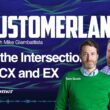For the record I have no problem with NPS. I want to get that out of the way right up front. NPS is one of the de-facto / baseline metrics that powers the entire CX industry. Thousands of organizations use Net Promoter Scores to guide their CX efforts – many of them successfully. I would be silly to oppose such a thing.
On the other hand …
IMHO most organizations use NPS improperly. Here’s what I mean – NPS, in its best use-case, measures customer sentiment against itself. In other words, the baseline for any improvement or decline in NPS is the change from a prior NPS number. For NPS to become actionable it can really only be so if it’s measuring the same conditions as the prior set of circumstances. That in itself is not a problem – it just is.
Said another way, NPS is a crummy starting point. It’s a much better indicator of progress than it is a baseline against which organizations can understand what customers expect and then figure out how to meet and exceed them. Which begs the question – how do organizations set that baseline? Where does one start if NPS’ real value is mostly longitudinal in nature?
Even customer journey mapping – which is designed to detect friction in existing processes so that they can be addressed, is largely executed without understanding what customers expect first – before those friction points were created.
A better starting point.
In my work at TheCustomer I’ve been privileged to participate in several research projects that were designed to understand consumer sentiment as it relates to purchase behavior on a category-by-category basis. For example, your conditions for a good (or perfect) experience for car shopping are unique and different from what you expect when you’re buying shoes, or groceries, or basically any other category of product or service. These studies are designed to uncover the emotional biases that go into customers’ expectations of the ideal experience in a particular category. (Special nod to Brand Keys for their research chops and to the sponsors who funded it).
What those studies produced was a very clear view of the emotional drivers (put a pin in that) that form the foundation for customers’ expectations for doing business in a particular category. Put another way, we can now know what customers expect – what their expectations are – before they are ever articulated through any NPS or CSAT exercise – which makes them the perfect starting point for optimizing CX.
Customer expectations are also predictive.
Because Brand Keys has been doing this kind of research for 25+ years they have an extraordinary trove of longitudinal data to measure the performance customer expectations as they relate to brand loyalty, brand performance – and even NPS and CSAT scores. The results, somewhat surprisingly, are off the charts, correlating at the 0.80+ level, which is extraordinarily high.
Remember the pin? What’s so important about the emotional drivers behind purchase intent? Or engagement? It turns out that those decisions and expectations are mostly emotional in nature. Yes, there are lots of product categories where the segment has been commoditized down to a price-only level (I’m sure there are some) but for the most part, any consumer engagement beyond those will have an overwhelming majority of drivers registering as emotional in nature. Brand Keys’ latest findings point to +/- 80% across most categories.
So why hasn’t the world adopted customer expectations as their CX north star? Answer – because it can be really expensive. To get a good sample requires starting with a huge population and then the task of understanding consumers’ emotionality is a complex process of triangulating insights and then verifying them. You wouldn’t be surprised to know that consumers don’t usually do what they say, they don’t say what they mean, and they almost never say what they feel.
Full disclosure.
About a year ago we began laying out a different approach to collecting and parsing all the consumer sentiment data and refining it down into its most useful CX essence. Today, that joint effort between TheCustomer and Brand Keys is called the Customer Expectation Audit. It consists of one category matrix – including all of the emotional drivers that make it, up along with their relative weights of importance – and one brand audit which measures the gaps between the brand’s performance against those expectations. Together, those two sets of measurements form a detailed roadmap of how brands can 1) understand their customers’ expectations, and 2) understand and prioritize the steps needed to meet them.
You can learn more about the Customer Expectation Audit here. And what I mentioned above about this kind of insight being too expensive? Due to a heavy re-engineering of the research process, Expectation Audits aren’t. Here’s to a better north star.
Photo by Say Cheeze Studios on Unsplash













